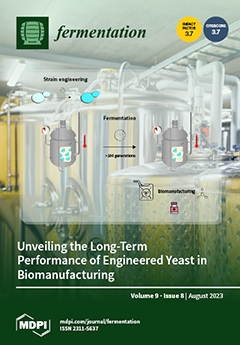The aim of the study was to analyze the effect of a plant feed additive based on
Artemisia absinthium and the metal trace element CoCl
2 (cobalt chloride II) on the metabolism of amino acids closely related to the energy of feed and the bacterial community of the rumen of Kazakh white-headed bulls. Animals were divided into four groups: (A)—the control group of animals received the basic diet (BD), (B)—animals of the experimental group I were additionally given
A. absinthium at a dose of 2.0 g/kg of dry matter (DM), (C)—II experimental group
A. absinthium at a dose of 2.0 g/kg DM with additional CoCl
2 (1.5 mg/kg/DM), and (D)—III experimental group was given only CoCl
2 (1.5 mg/kg/DM) to study the rumen metabolism of amino acids and bacterial diversity of animals, rumen cannula were installed, the experiment was carried out using a 4 × 4 Latin square. It was found that additional feeding of
A. absinthium, both separately and in combination with CoCl
2, led to a change in the indices of the alpha biodiversity of the bacterial community. Correlation analysis revealed a linear relationship between the concentration of amino acids and the rumen bacterial community (
p ≤ 0.05). The relationship between the values of amino acid concentrations and certain OTUs was established, with a possible percentile probability of 95% for the genera unclassified Lachnospiraceae, unclassified Clostridiales, unclassified Bacteroidales, Fibrobacter, Ihubacter, Phocaeicola, Paludibacter, Akkermansia, Vampirovibrio, unclassified Ruminococcaceae, and Alistipes. Thus, the use of
A. absinthium and CoCl
2 as feed additives, both in combination and without, leads to a change in the taxonomic structure affecting the concentration of amino acids. However, further research is needed to better understand the effectiveness and safety of these supplements.
Full article
 to open them.
to open them.




